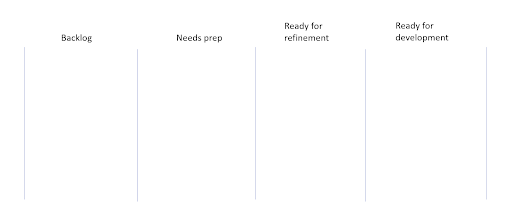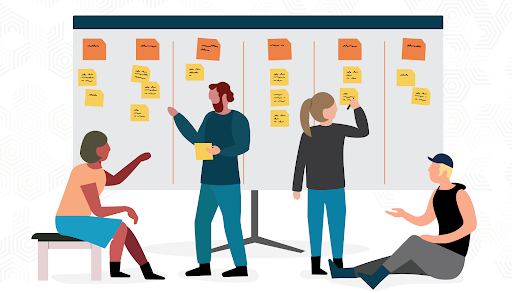If your team is like most others, you don’t spend enough time on backlog refinement.
Some teams don’t want to “waste” time in meetings. Others would "rather do the work than talk about it". The best Agile teams know that backlog refinement is a key to success. And the absolute top performing teams focus on refinement preparation - they prepare work items before a refinement session even begins.
Below I am going to show you exactly how to shorten your backlog refinement sessions, while getting more out of them. And you will learn how a Kanban board can help you meet your goals and drive teams forward.
Good Agile needs backlog refinement
Without backlog refinement, you can’t have better Agile.
Why? Because backlog refinement is instrumental in feeding the team the top priority items in a clear, right-sized format. Without good input, the team cannot perform good work. Refinement is the guarantee for good input.
Backlog refinement is where the Product Owner and the team get aligned. During the session, they work on the backlog items at the top of the product backlog, and make them ready for the work to start in sprints.
Get more out of your refinement meetings by preparing
Some people say: “Why bother preparing for a refinement meeting? Isn't the actual meeting for discussion and understanding?”
That is true. Refinement is a place for discussion. But discussion has a way to fill a lot more time than you anticipate. With an unprepared starting point, a lot of time in the refinement meeting can be wasted. Talking and listening is not a very efficient form of communication, compared to reading.
If your team needs to cover a lot of work items, they won’t be able to go into much detail. Let’s say your team wants to cover five work items in an hour. That leaves you with 12 minutes per item.
I don’t know about you, but I need way more than 12 minutes to discuss and understand complex topics. Instead of making things more clear, a too quick glance at a complex item might even add to the team’s level of stress.
By preparing work items before refinement, the team has an advantage. They can draft, review, and enhance acceptance criteria. Or take a glance at the actual items up for discussion to get a head start. With good preparation, you can cut down the hour those five items would have taken to complete - to 30 minutes.
With focus on preparation, you can make the actual meeting shorter. Instead of “just another time-wasting meeting” the team will start to see the extreme value that this short, focused refinement approach will bring. Disciplined preparation will lead to better results and less stress.
Product Owner-centric preparation
Some teams leave the Product Owner to do the preparation. While this approach beats the “no preparation” approach, it also has its downsides.
Yes, the Product Owner is an expert on the product and customer needs. That doesn’t mean they are the best expert on everything. Other team members might have more knowledge and different, valuable viewpoints on the problem.
If Product Owners alone cover the preparation, the rest of the team also stops being as involved. Doing the preparation makes the team members feel more ownership of the work itself. This leads to better refinement.
That’s why, in an ideal world, team members share the preparation work. The Product Owner could assign preparation tasks to individual team members. While assigning preparation tasks does work, it doesn’t fully follow Agile principles. In Agile, no “manager” assigns tasks to team members. Instead, team members volunteer and commit to the work together.
How your team can organize the preparation
To better organize and prepare your work, you need visibility and discipline.
To tackle visibility, you need a backlog refinement Kanban board. The board could look like this:

How to use the board:
- On Wednesday, the Product Owner moves stories from the “Backlog” column into the “Needs Prep” column.
- During the Thursday morning meeting, team members review the “Needs Prep” column. They can now volunteer to prepare items.
- The team prepares on Thursday, Friday and Monday. The deadline for this preparation work is on Monday afternoon at 2 p.m.
- After 2 p.m. on Monday, but before the Tuesday meeting, team members go and read through the prepared stories at their leisure.
- Tuesday morning, the team holds the backlog refinement meeting.
This practice requires your team to agree on these deadlines for the preparation work. It should become a self-directed ceremony. Achieving this requires a few weeks of practice while these deadlines are enforced.
Volunteering at the end of a refinement session
The more prepared you are for backlog refinement meetings, the shorter they are. This leaves you with extra time to check out upcoming work items and even volunteer for them.
A truly efficient team could do step 2 - volunteering - at the end of each Tuesday refinement session. This is possible if the Product Owner is already thinking of the next week’s refinement topics. Talk about efficiency!
Encourage your team members to challenge each other
At a glance, having the top expert prepare a work item looks like the best solution. But that could discourage others from challenging their conclusions.
Team members should feel safe enough to challenge the views of senior members. Good, mature teams know this. But more novice teams might not yet have such an environment. This could lead you to miss out on interesting and valid counter-points.
An effective Scrum Master makes sure the team strikes the right balance. The team must be encouraged to both prepare and challenge the preparation that's done.
The Kanban board highlights visibility and discipline
The Kanban board is the best tool to achieve visibility and discipline by making the status and progress of the preparation work visible.
This process drives your team forward and helps them get more out of backlog refinement.
Published: Mar 8, 2022



